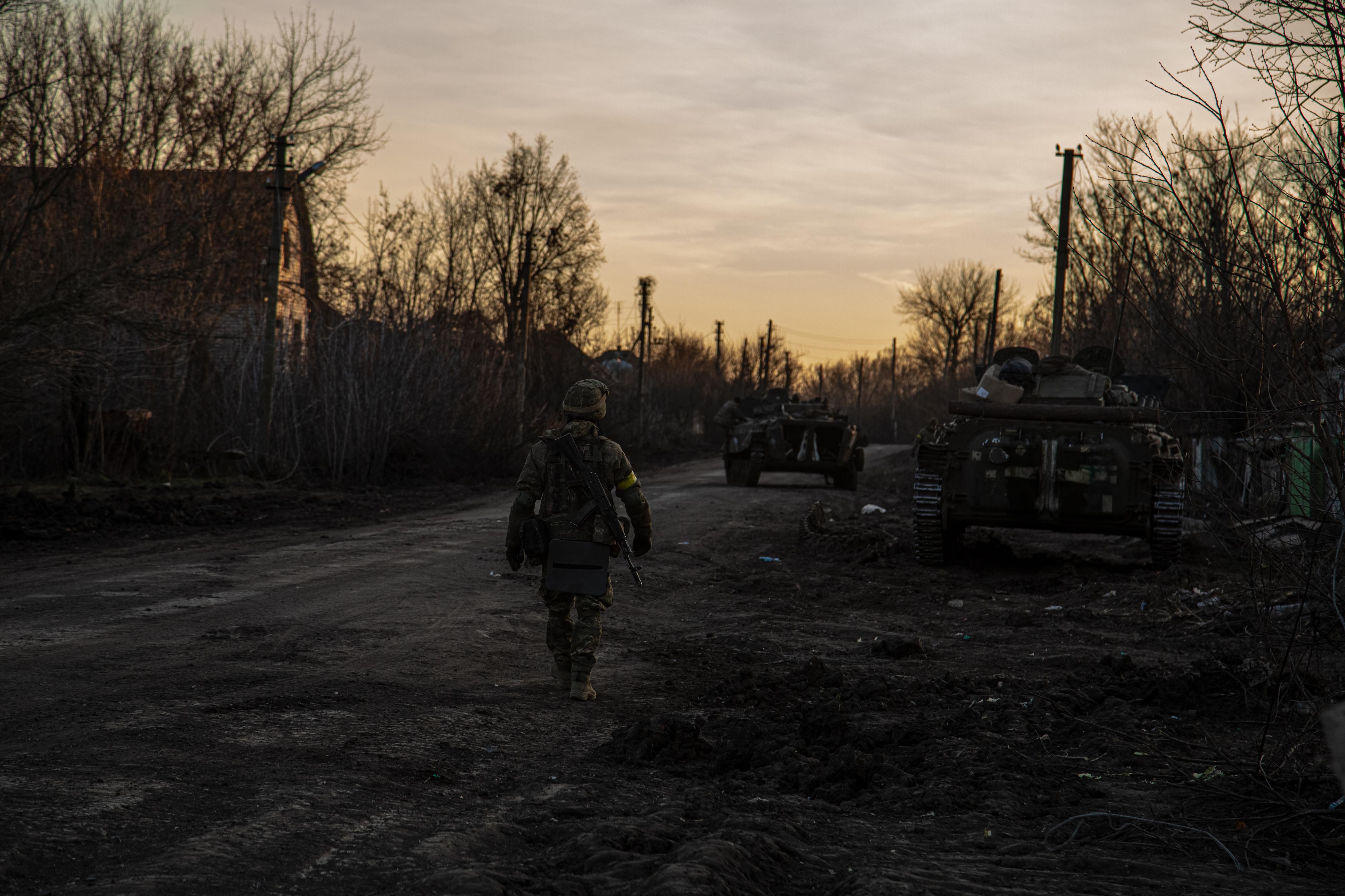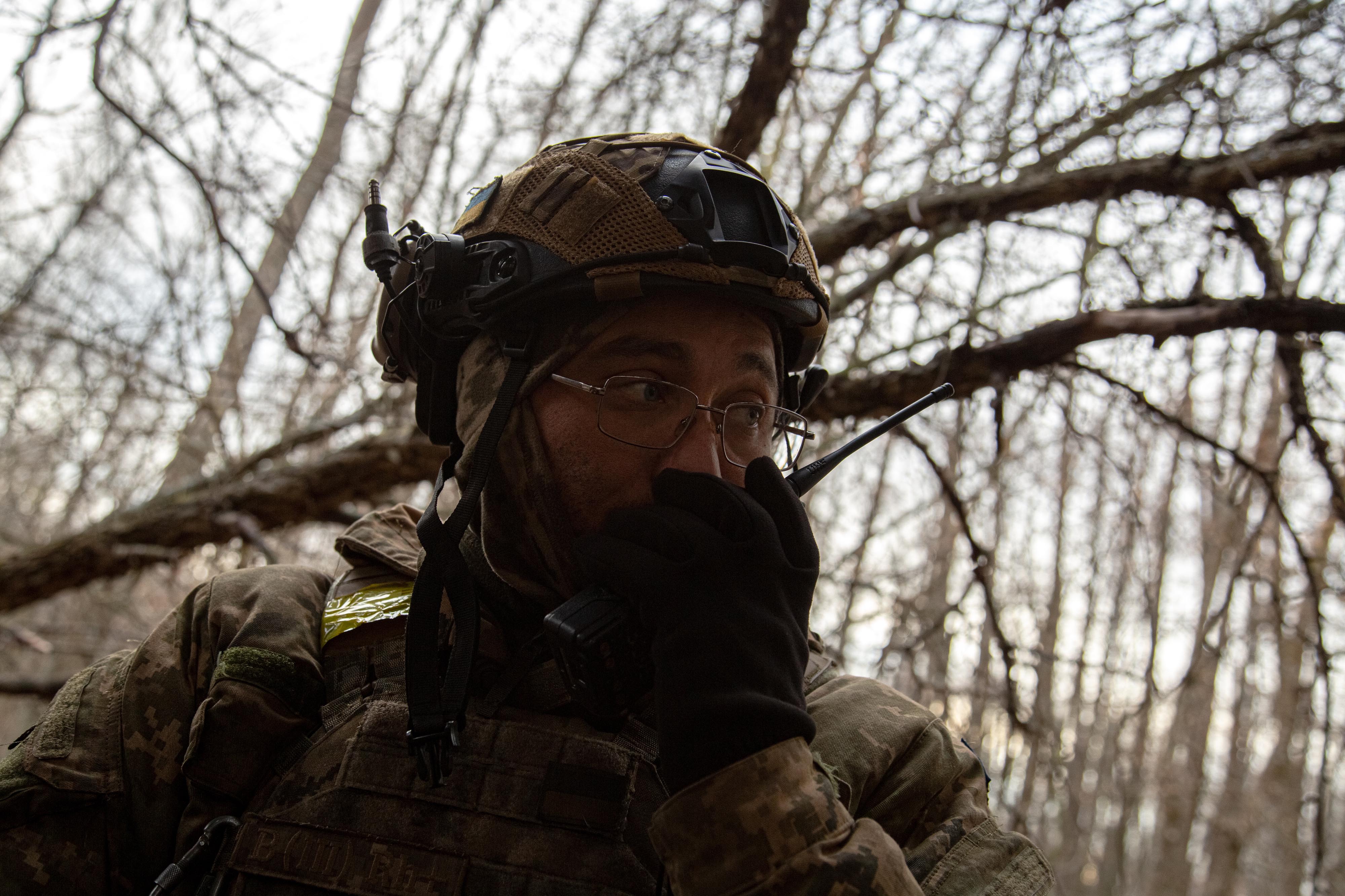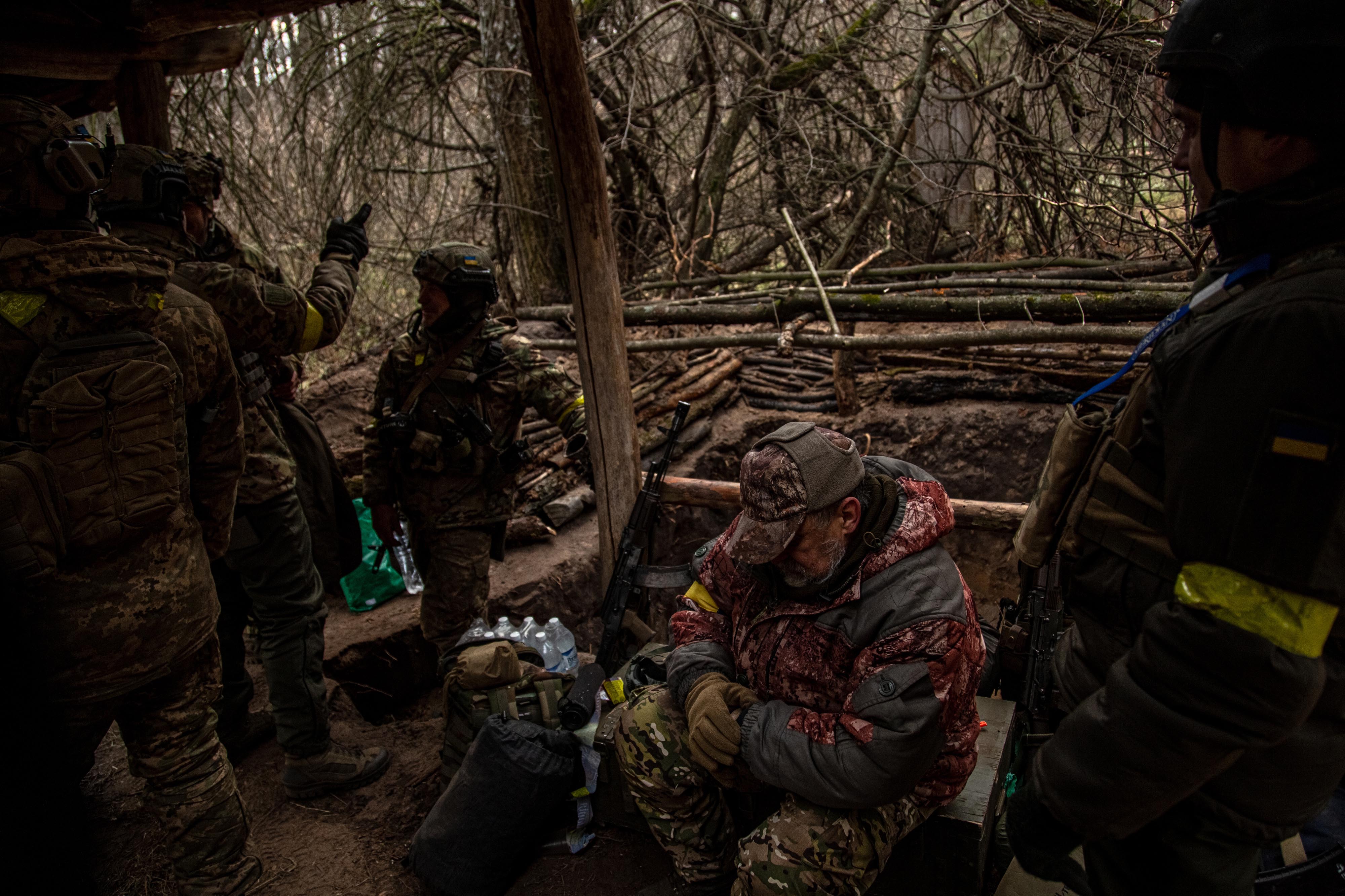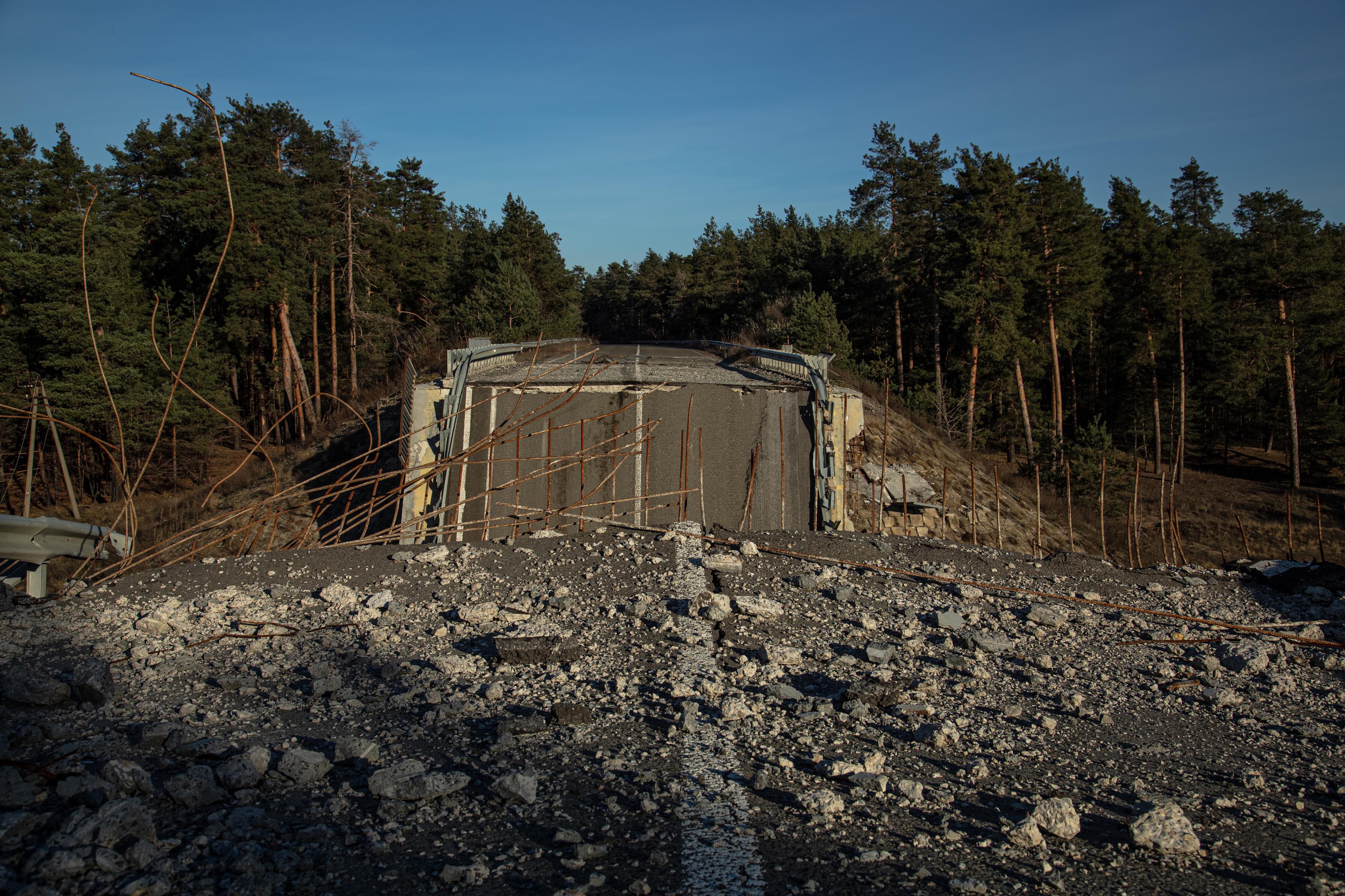Life on the eastern front with Ukraine’s troops
After the rapid progress of Ukrainian forces in the Kharkiv region, progress has slowed in Luhansk as the wet and cold weather moves in, writes Isabelle Khurshudyan

Deep in the forest and less than a mile from enemy Russian positions, the sound of incoming artillery landing nearby thunders every few minutes. The landscape is littered with unexploded ordnance, so the Ukrainian soldiers don’t dare step anywhere they have not before. They pack light because they might be on the move quickly – forward, they hope.
In their cramped, hastily dug mud outpost, they apologise that they only have tea – no room for coffee.
A commander manning one of Ukraine’s forward-most positions did not flinch at the roar of shells crashing close by as he zoomed in on his tablet to show how Kyiv’s forces in the area have advanced within five miles of Kreminna – an occupied stronghold for the Russian military and potential gateway for the Ukrainian forces as they press into the eastern Luhansk region.
“We’ve pushed them back, and now we just need to take their logistical routes,” says the deputy battalion commander in the Ukrainian National Guard’s 5th Slobozhanska Brigade, with whom it was agreed to identify by his call sign, Tor, because of the security risks.
“As soon as they lose that, they’ll have to abandon their positions,” Tor says. “They won’t be able to bring in reinforcements or more ammunition.”
Less than a month after Moscow withdrew its troops from the western bank of the Dnieper River and the city of Kherson – the sole regional capital Russia had captured in this invasion – the focus of the war has once again turned to eastern Ukraine, where Russia has stoked armed conflict since 2014.
Here, Ukraine is still on the offensive. But the gains are slower and harder-fought than the surprise counteroffensive that expelled Russian forces from nearly the entire northeast Kharkiv region in just one week in September.
The fight here epitomises the grinding pace that military analysts and Western intelligence officials expect the war to slow to this winter. Ukrainians have refuted suggestions of an operational pause, saying that would just give Russia time to regenerate its forces at a moment they appear weakened.
But Ukrainian soldiers concede that the battles in the eastern Donetsk and Luhansk regions, collectively known as Donbas, are tougher – perhaps reflecting the new priority of Russian President Vladimir Putin and his commanders: avoiding further defeats after the humiliating retreats from the north and south.

Putin has repeatedly said that the main goal of his war is to “liberate” all of Donbas, meaning losses in the region would mark a clear and obvious failure.
Front lines here are well-reinforced by second and third waves of Russian defences. Sometimes reinforcements are brought in hours after a Ukrainian attack – often recently mobilised fighters.
Oleh, a company commander for one of the Ukrainian brigades fighting near Kreminna, says that after his unit attacked Russian positions in a village north of the city, drone reconnaissance observed two trucks bringing in more soldiers early the next morning.
“The enemy just brings in the mobilised in piles, and they just get pushed to the front, without any training,” he says. It was agreed to withhold Oleh’s surname because he still has family members living under Russian occupation in his home.
“There’s a lot of them,” Oleh says of the Russians. “They just bring them here as meat.”

The Ukrainians are fighting to hold off a mass of enemy forces, including mercenaries, in the Donetsk region city of Bakhmut, currently the site of the bloodiest battle in the war. Their goal is to keep Russia from attempting to encroach on the cities of Kramatorsk and Slovyansk.
Meanwhile, Ukraine has started to make gains at the edges of the occupied Luhansk region, which directly borders mainland Russia. Multiple brigades are attacking on two fronts – from the north, toward the occupied city of Svatove, and here from the east, toward Kreminna.
Taking both would threaten Russia’s hold on the cities of Severodonetsk and Lysychansk, which Moscow’s forces captured in much-hyped victories in late June and early July, following fierce battles.
“Any failure for them now is devastating, so they’re fighting hard for every little piece,” Tor says. “They fought many months for Lysychansk, and they’re about to lose it.”
Mixed in with the inexperienced troops are veteran forces. Oleh says “Kadyrovites” – Chechen forces fighting for Russia – had stormed his unit’s positions over the weekend but took heavy losses.
“They don’t even try to recover the bodies of their dead,” he says. “Today, for example, they abandoned one of their wounded. We tried to help the man and evacuate him, but he didn’t survive.”

Oleh says contract soldiers from the Wagner mercenary group are also fighting in the area. Pro-Russian social media accounts have posted images of a vast “Wagner line” of defence – two rows of concrete pyramid blocks intended to stop tanks – stretching around parts of the occupied Donetsk and Luhansk regions and even along the Russian border.
Earlier this month, soldiers in Ukraine’s 92nd Mechanised Brigade fighting on the northern edge of the Luhansk region, near Svatove, shrugged off those fortifications. “Boys, tell me, this . . . concrete triangle, would you shatter it with direct fire?” asks Oleksandr, a captain, who spoke on the condition that only his first name be used.
“Yes, of course, it’ll turn to dust,” replies a soldier standing on top of a “trophy” T-72 tank, which was seized from retreating Russian forces along with the equipment to repair it and the ammunition to arm it.
At that point, Oleksandr complains that the main thing hindering the Ukrainian advance was the mild, wet weather. Troops – and their tanks and armoured personnel carriers – were literally stuck in the mud. But just a week later, a drop in temperature has made the battleground firmer and more favourable.

The freeze also has its drawbacks. Soldiers in Tor’s unit posted in the forest near Kreminna are so close to Russian forces that they won’t dare to heat their outdoor living quarters, which could reveal their location to Russian drones flying overhead. They sleep in their coats, under light sleeping bags in the cold open air.
A week ago, they were some five miles farther back in this same forest.
One day’s events feel like a month’s worth here. There is just one narrow dirt road that winds into the forest. The Russians know it is a lifeline for the Ukrainians – used to bring in reinforcements and to evacuate any wounded – so they hit it constantly with artillery. At its edges are destroyed vehicles that in the past few days veered off just slightly to make room for oncoming traffic – and unluckily hit a mine.
Last week, while evacuating a wounded Ukrainian soldier with shrapnel wounds in his stomach and side that were causing internal bleeding, Kabashnuy, a member of Tor’s unit, sped down the bumpy road to get the soldier medical help faster. The man screamed in pain from the back seat while another soldier tried to hold him down. Slowing down could mean death – more shelling could occur at any moment – but driving too fast could cause the wounded man harm, too.
Just an hour after Kabashnuy drove us up the road to the unit’s front-line position, the ride back looked different. New trees and branches were strewn across the road – signs of recent shelling. There was a fresh crater, too.
“Something has already changed,” Kabashnuy says, while his comrade rushes out of the car to move a fallen tree out of the way. “This is how we live here.”
Serhiy Morgunov and Kamila Hrabchuk contributed to this report.
© The Washington Post




Join our commenting forum
Join thought-provoking conversations, follow other Independent readers and see their replies
Comments